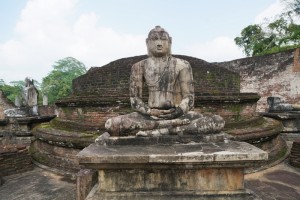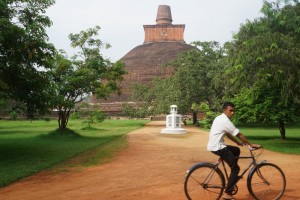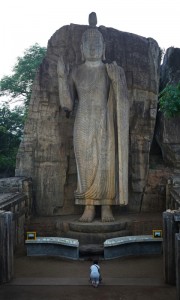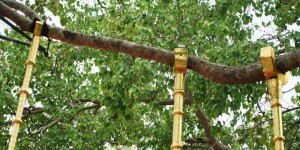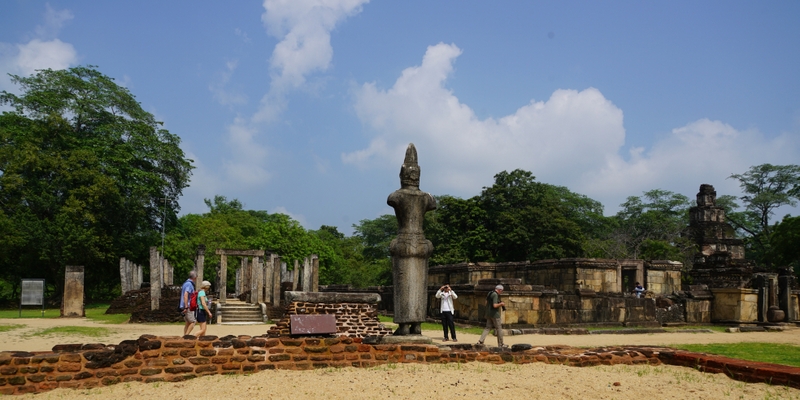Pilgrimage Tour- Anuradhapura, Polonnaruwa & Kandy: December 1 – 5, 2016
I joined a pilgrimage trip to Shikoku, Japan organised by a Buddhist charity organisation in Hong Kong in December 2012. When I discovered it would be organising a pilgrimage tour to Sri Lanka on December 1 – 5, I decided to join after my African trip. My friend Cat joined me and we spent five more days in Sri Lanka after the pilgrimage trip.
Sri Lanka, an island nation near south-east India with documented history of 3,000 years with evidence of pre-historic human settlements dating back to at least 125,000 years. Given its geographic location and deep harbours, it has strategic importance since the time of ancient Silk Road. The history of Sri Lanka can be divided into several periods.
Pre-Anuradhapura Period: The original inhabitants, according to the Mahavamsa (a chronicle written in Pali), are Yakshas and Nagas. Sinhalese history traditionally starts in 543 BC with the arrival of Prince Vijava, a semi-legendary prince who sailed with 700 followers to the island after being expelled from Vanga Kingdom (present-day Bengal). He established the Kingdom of Tambapanni (near modern-day Mannar) and is the first of the approximately 189 native monarchs before the dynastic history of Sri Lanka ended in AD 1815 when the land becoming part of the British Empire.
During this period, Buddha visited the island three times: Mahiyangana in 528BC, Nagadipa (present day Jaffna) in 523 BC and Kelaniya in 519/520 BC with 500 of his followers. On the last visit Buddha left his left foot print on top of Sumanakuta/Samanalakanda (present day Adams Peak) on the invitation of a Naga prince.
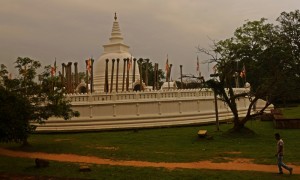 Anuradhapura Period (380 BC- early 11th century): The Anuradhapura Kingdom was established in 380 BC and last for nearly 1,400 years with Anuradhapura as the capital. In 250 BC, Mahinda, son of Mauryan Emperor Ashoka and a Buddhist Monk arrived in Mihintale whose mission was to spread Buddhism. In 245 BC, the monk Sangamitta arrived with the Jaya Sri Maha Bodhi tree, which is considered to be a sapling from the historical Bodhi tree under which Gautama Buddha became enlightened. It is considered the oldest human-planted tree (with a continuous historical record) in the world.
Anuradhapura Period (380 BC- early 11th century): The Anuradhapura Kingdom was established in 380 BC and last for nearly 1,400 years with Anuradhapura as the capital. In 250 BC, Mahinda, son of Mauryan Emperor Ashoka and a Buddhist Monk arrived in Mihintale whose mission was to spread Buddhism. In 245 BC, the monk Sangamitta arrived with the Jaya Sri Maha Bodhi tree, which is considered to be a sapling from the historical Bodhi tree under which Gautama Buddha became enlightened. It is considered the oldest human-planted tree (with a continuous historical record) in the world.
Sri Lanka played an important role in the history of Buddhism. The Fourth Buddhist Council of Theravada Buddhism was held at Anuradhapura Maha Viharaya under the patronage of the king in 25 BC. In order to prevent the teachings in the form of oral literature being lost, palm-leaf manuscripts containing the complete Canon were produced and some were taken to other countries such as Burma (present day Myanmar), Thailand, Cambodia and Laos. The kingdom maintained a large number of Buddhist schools and monasteries and supported the propagation of Buddhism into these countries.
Some remarkable construction projects were completed during this period. The Sigiriya, the “Fortress in the Sky”, was built during the reign of Kashyapa I of Anuradhapura (477 – 495). The 1,600-year-old Sigiriya frescoes are an example of ancient Sri Lankan art at its finest. Large reservoirs, canals and elaborate aqueducts were also constructed.
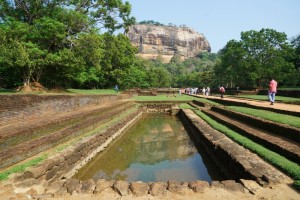 Polonnaruwa Period (the medieval period; 11th – 13th centuries): In 993, the Chola invaded the kingdom and forced the monarch to flee Anuradhapura which was sacked in 1017. Subsequently they moved the capital to Polonnaruwa. In 1070, Vijayabahu I forced the Chola out and reunited the country.
Polonnaruwa Period (the medieval period; 11th – 13th centuries): In 993, the Chola invaded the kingdom and forced the monarch to flee Anuradhapura which was sacked in 1017. Subsequently they moved the capital to Polonnaruwa. In 1070, Vijayabahu I forced the Chola out and reunited the country.
Despite the short duration of this period, the Sinhala kingdom reached great heights owing to its rulers who were devoted to fostering agriculture, religion and social development. The country’s irrigation system was extensively expanded during the reign of Parakramabahu the Great (1153-1186) and his most famous project is the Parakrama Samudra, the largest irrigation project of this era.
Transition Period: In 1215, Kalinga Magha, a South Indian and founder of the Jaffna kingdom, invaded and captured the kingdom of Polonnaruwa. He looted, ransacked and destroyed everything in the ancient Anuradhapura and Polonnaruwa Kingdoms beyond recovery. During his reign, he extracted as much as possible from the land and overturned as many traditions as possible. King Vijayabahu III led the resistance and brought the kingdom to Dambadeniya. The north eventually evolved into the Jaffna kingdom while the south and central Sri Lanka were ruled as different kingdoms. Chinese admiral Zheng He and his navy landed at Galle in 1409 where he captured the local king.
Kandyan Period: Foreign explorers, traders and colonisers began to arrive in the 16th century. In 1505 The Portuguese arrived in 1505, built a fort at the port city of Colombo in 1517. They were engaged in intermittent warfare with the monarch. In 1619, Jaffna kingdom attacked by the Portuguese, came to an end. After the defeat of the Portuguese by the Dutch, Colombo fell into the Dutch hands by 1656.
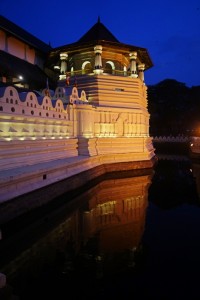 The Kingdom of Kandy was the last independent monarchy of Sri Lanka. In 1592, Vimaladharmasuriya I moved his kingdom to Kandy, an inland city which would be more secured from attack. In 1695, the king brought the sacred Tooth-Relic – the traditional symbol of royal and religious authority amongst the Sinhalese – to Kandy and built the Temple of the Tooth.
The Kingdom of Kandy was the last independent monarchy of Sri Lanka. In 1592, Vimaladharmasuriya I moved his kingdom to Kandy, an inland city which would be more secured from attack. In 1695, the king brought the sacred Tooth-Relic – the traditional symbol of royal and religious authority amongst the Sinhalese – to Kandy and built the Temple of the Tooth.
British Rule (AD 1815 -1948): During the Napoleonic War, Great Britain fearing that Colombo which had been controlled by the Dutch might be taken over by the French, occupied the coastal areas in 1796. Later the entire coastal area was under the British East India Company as a result of the Treaty of Amiens. On February 14, 1815, Kandy was occupied by the British in the second Kandyan War ending Sri Lanka’s independence with the last native monarch exiled to India. The Kandy Convention formally ceded the entire country to the British Empire.
From the beginning of the British colonial rule until 1972, the island was known as Ceylon. The British introduced plantation of coffee, tea, rubber and sugar to the island. Reforms were introduced in 1833. Universal suffrage was introduced in 1931 and free education system in 1945.
Modern and Independent Sri Lanka: Independence was proclaimed on February 4, 1948. The young nation had a prolonged tumultuous period of political instability, conflicts amongst ethnic groups and rise of the militant Tamils which formed the Liberation Tigers of Tamil Eelam (LTTE). The 26-year civil war killing 80-100,000 people and devastating the country, finally ended when the government forces defeated the LTTE in 2009.
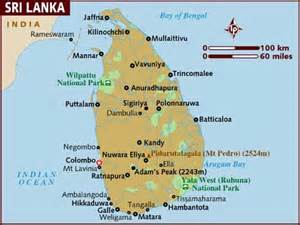 Sri Lanka Today: Sri Lanka with an area of 65,610km² and a population of over 22.2 million (2016 estimate), is a beautiful island nation in Indian Ocean. With a coastline of 1,585km and abundant water resources with 103 rivers, over 2000 reservoirs and an extensive irrigation system, the country’s main economic sectors are tourism, tea export, clothing, rice production and other agricultural products. Overseas employment, especially in the Middle East, contributes substantially in foreign exchange. It has emerged after the ending of the 26-year year civil war to become of the fastest growing economies of the world. Its estimated GDP nominal and PPP in 2016 are $82.239 billion and $237.197billion respectively (i.e. a per capita of $3,870 and $11,189 respectively).
Sri Lanka Today: Sri Lanka with an area of 65,610km² and a population of over 22.2 million (2016 estimate), is a beautiful island nation in Indian Ocean. With a coastline of 1,585km and abundant water resources with 103 rivers, over 2000 reservoirs and an extensive irrigation system, the country’s main economic sectors are tourism, tea export, clothing, rice production and other agricultural products. Overseas employment, especially in the Middle East, contributes substantially in foreign exchange. It has emerged after the ending of the 26-year year civil war to become of the fastest growing economies of the world. Its estimated GDP nominal and PPP in 2016 are $82.239 billion and $237.197billion respectively (i.e. a per capita of $3,870 and $11,189 respectively).
Sri Lanka is a diverse and multicultural country with a high literacy rate of 92%. The Sinhalese are the largest ethnic group comprising some 75% of the population. The other main ethnic groups include Sri Lanka Tamil 11.2%, Sri Lanka Moors 9.2%, India Tamil 4.2% (2012 est.).
The country has a rich Buddhist heritage with the longest continuous history of Buddhism of any predominantly Buddhist nation. About 70% of the population follow Buddhism which is given special recognition in the Constitution. Hinduism which predates Buddhism, is the second most prevalent religion and Hindus are mainly Tamils. About 13%, 10% and 7% of the population follow Hinduism, Islam and Christianity respectively.
Sri Lanka has rich history and culture, fauna and flora and boasts eight World Heritage Sites. Five of the sites are related to its Buddhist heritage (the ancient cities of Polonnaruwa and Sigiriya, the Gold Temple of Dambulla, and sacred cities of Anuradhapura and Kandy). Two are natural sites namely Sinharaja Forest Reserve and the Central Highlands of Sri Lanka. The old town of Galle and its fortifications traces the arrival of European explorers and colonisers. Last year, the country received 1.8 million international tourists representing an increase of 17.8%.
November 31: Dubai – Colombo, Sri Lanka
I landed at the Colombo airport before 8am only to be told that my online visa application had not been approved/processed. I used my HKSAR passport and had ticked ‘Hong Kong’ instead of ‘China/Chinese’ under the nationality column. As a result, a visa was not issued accordingly. I paid $35 online but had never been notified of the problem by email.
The immigration staff told me to apply in person at the visa counter. My application was already in the computer system and I got one immediately after I paid another $40. It is not fair to applicants. The immigration staff suggested me take the issue up with the online visa handling agent and get a refund (I must follow up. In my view I should be duly informed online so that the inadvertent mistake could be rectified instantly.) I wasted at least over 30 minutes as a result of the visa problem.
I found half a dozen money changers and banks at the arrival hall. I changed US$200 (the exchange rate was $1 to Rs148). I was surprised to be met on arrival by a representative of Gateway Hotel Airport Garden. My agent in Hong Kong had not informed me about the free transfer (of course nothing is free: I have already paid $160 a night for a room with breakfast. It is the same price for one or two persons). As I had not slept for over 30 hours, I took a nap and spent the rest of the day relaxing in my spacious room writing about my Kilimanjaro climb.
5-Day Pilgrimage Tour December 1-5, 2016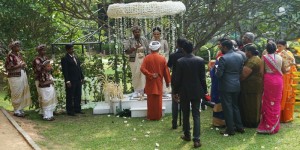
Day 1: Colombo
The pilgrimage group would depart Hong Kong in the evening and arrive in Colombo after 11pm. I had another relaxing day doing very little. While enjoying a late buffet breakfast, I watched a Sinhalese wedding ceremony that took place in the garden. The Buddhist ceremony with an Indian flavour was administered by a monk and attended by the immediate family. In the evening, the couple hosted a banquet in the hotel for 200 guests in western style! Interesting!
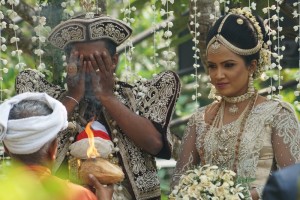 |
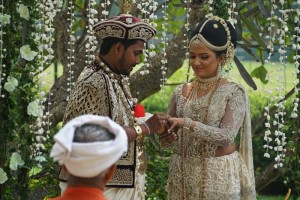 |
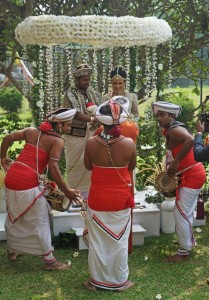 |
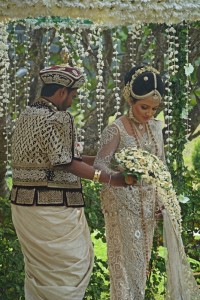 |
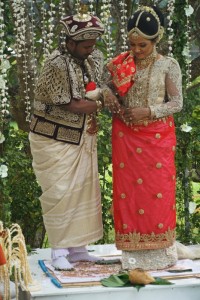 |
I met Cat, Patrick from the Buddhist charity organisation, MK from Westminster Travel and Rex, the local guide who speaks Putonghua when they turned up at the hotel almost at 1am!
Day 2: Anuradhapura
Cat and I had less than three hours’ sleep. By 8:30am, we were ready for departure. There were 33 participants in the group. As it’s a short pilgrimage trip, we had no time for sight-seeing. We drove some 200km to Anuradhapura which was made a capital by King Pandukabhaya according to a well-organised plan in the 4th century BC. It remained the capital for 1400 years with 113 kings and is considered sacred in the Buddhist world. With the strong support of the royal family and nobility for Buddhism, Anduradhapura gained more prominence with many temples being built and works of art commissioned for donation to temples. The city was the ritual / religious and administration centre. When the capital moved to Polonnaruwa, the area was uninhabited for many centuries though remained a place for pilgrimage. Excavations began by Stephen Montagu Burrows in 1884-86.
Today, the ruins consist of three classes of buildings,dagobas(bell shaped masses of masonry), monastic buildings and pokunas(bathing tanks or tanks for the supply of drinking water). The eight great places of veneration here include the Jaya Sri Maha Bodhi, Ruwanwelisaya, Thuparamaya, Lovam ahapaya, Abhayagiri Dagaba, Jetavanarama, Mirisaveti Stupa and Lankarama. We arrived at our first stop of our trip around 2pm. Rex took us to a museum and gave us a brief history of this period. The exhibits in the museum include many sculptures and artifacts including coins, jewelry, ceramic, pots etc.
We walked past a pokunas and many monastic buildings before arriving at the Jetawana Stupa, the biggest stupa in the world. Initiated by King Mahasena during his reign (273-301), the stupa was completed by his son Maghavanna I. A part of a sash or belt tied by the Buddha is believed to be the relic enshrined here. The 122m- high stupa with a base-area of 233,000m²which foundations structure were 8.5m deep and built with 93.3 million baked bricks, was covered with shrub jungle until 1909. The compound comprising 5.6 hectares and belonging to the Sagalika sect, had housed 10,000 Buddhist monks in its heydays.
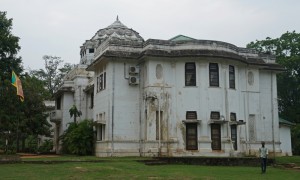 |
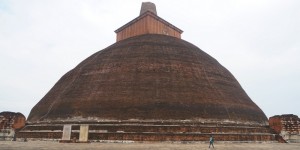 |
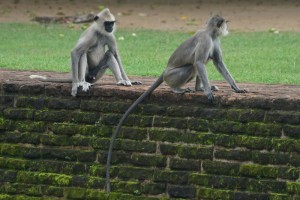 |
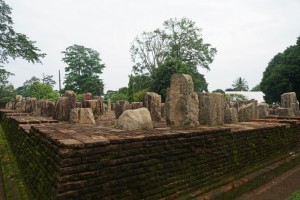 |
We passed by the famous Thuparama Stupa and Ruwanwelisaya Stupa without any stop. What a pity!
Our second stop was at Jaya Sri Maha Bodhi, the sacred tree planted in 288BC in the Mahamewna Gardens. It is said to be the right-wing branch from the historical Sri Maha Bodhi at Buddha Gaya.
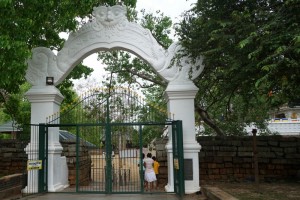 |
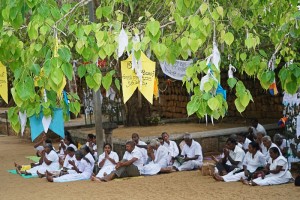 |
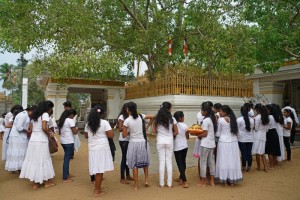 |
Our final stop of the day was to see the 12m-high standing Avukana Buddha. It was carved out of a large granite rock face during the 5th century. The hands of the Buddha are in ‘Asisa mudra’ position and its flowing robe is most beautifully carved. At 7pm, we finally arrived at Hotel Habarna where we stayed for two nights.
Day 3: Polonnaruwa
Today, we visited two most important sites built in Polonnaruwa, which was first declared the capital city by King Vijayabahu I who defeated the Chola invaders in 1070 to reunite the country. The golden age of this short-lived kingdom was during the reign of Parakramabahu when trade and agriculture flourished.
This ancient city comprising a citadel (or inner city) and an outer city, remains one of the best planned archaeological relic sites in the country. The former had the king’s palace and other buildings of the royal court and household as well as the buildings for administration. The latter spread far and wide containing many religious shrines, the chief of which is the Sacred Quadrangle where the Sacred Tooth Relic of the Buddha was enshrined.
We began our visit at the museum which tells the history of this short era with some outstanding exhibits. But it is impossible to fully appreciate the exhibits in 45 minutes. But this quick tour gives me an idea about this World Heritage Site and its main attractions.
The highlight of our visit here was a meditation session in the Tivanka Image House which is famous for its wall paintings. According to Rex, this building is not open to the public. Special arrangement had been made for our pilgrimage group and we were met by a senior monk who medicated with us. Though I do not know how to meditate, I have had a wonderful experience while sitting peacefully in this historical and spiritual ruin. I am interested in the paintings of the invocation of deities (Devaradhana) which followed the grand tradition depicting a rhythmic flow of line and figure.
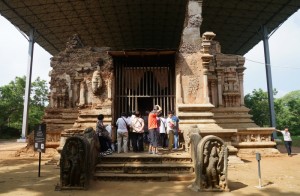 |
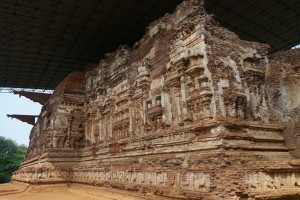 |
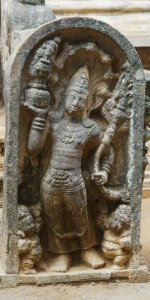 |
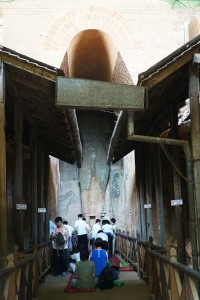 |
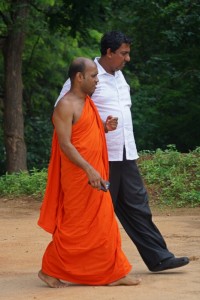 |
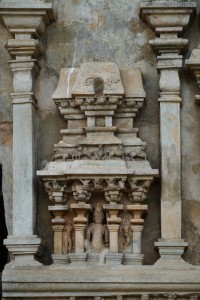 |
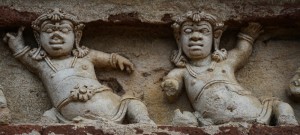 |
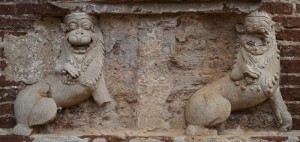 |
When Rex told me that we would be leaving without stopping at the Sacred Quadrangle, I said we should not leave without visiting this most important part of the ancient capital and suggested a shorter lunch break. Realising my keen interest, Rex arranged a 20-minute break for us.
While a few participants with walking problem stayed in the coach, the rest of us had a most wonderful time taking a quick look at the Vatadage (the relic house of the 12th century built in the shape of a circular stupa with four entrance doors oriented to the cardinal points and the most beautiful moonstone in the country), Hatadage, Atadage, Thuparama (an image house), Bodhisativa, Recumbent Image House, Bodhi Tree Shrine and Satmashai. The stupa, Buddha statues, sculptured columns and the moonstones are most impressive.
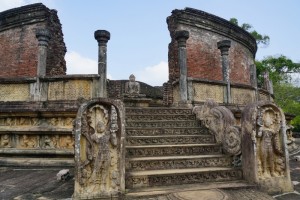 |
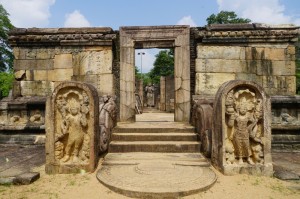 |
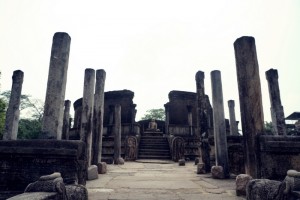 |
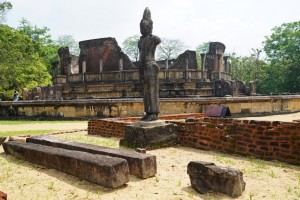 |
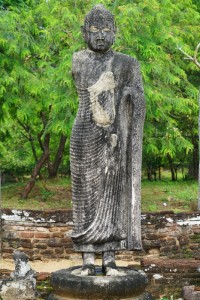 |
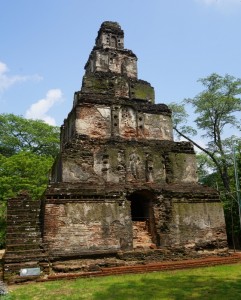 |
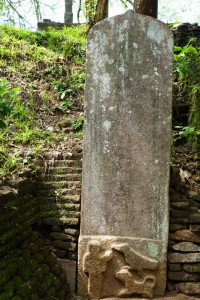 |
After a vegetarian lunch in a Chinese restaurant, we spent the afternoon in Sigiriya (the Lion Rock), an ancient rock fortress surrounded by an extensive network of ramparts and moats. Inside the protective enclosure were gardens, ponds, pavilions, palaces and other structures.
This site was chosen by king Kasyapa for his new capital. The king built his palace on the top of the rock and decorated its sides with colourful frescoes. He also built a gateway in the form of an enormous lion on a small plateau. The capital and the royal palace was abandoned after the king’s death. It was used as a Buddhist monastery until the 14th century.
The 200m-high Sigiriya Rock looks majestic. We had to walk 1200 steps to reach the top! Half way up, we stopped at the “Cobra Hood Cave” with paintings of 18 ladies. Identities of these ladies are unknown. But the pictures with vivid colours have a close resemblance to those in the Ajanta caves in India.
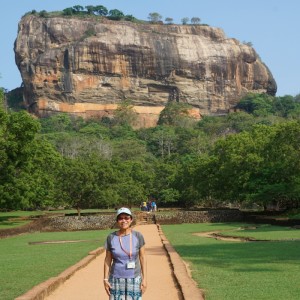 |
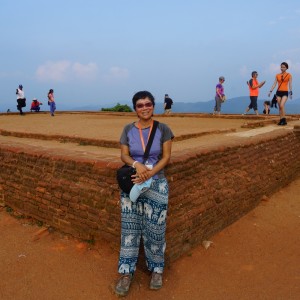 |
We continued our climb and soon reached the platform with the lions at the entrance of the gateway. The steep staircase to the top is narrow and can be scary to those afraid of height. The panoramic views of the expansive plains and forests below are awesome.
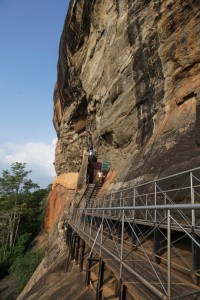 |
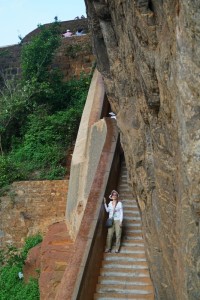 |
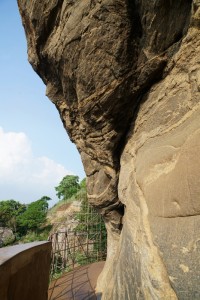 |
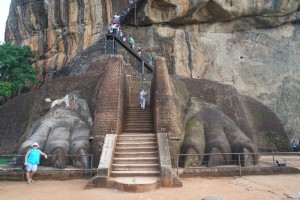 |
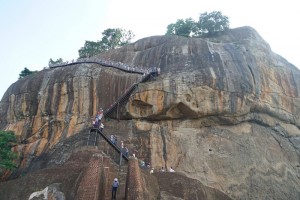 |
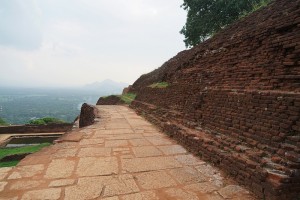 |
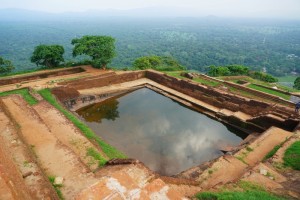 |
We left at 5pm with a brief shopping stop where some of us could change money. The rate offered was US$1 to Rs140. We were back in the hotel before 6pm and had dinner at 7pm. I must have eaten something wrong: I vomited a dozen times and could not sleep till 3am.


